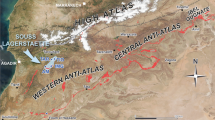Abstract
THE almost complete skeleton of an elk or moose (Alces alces L.) associated with two uniserial barbed points of bone or antler has recently been recovered from one horizon of a series of freshwater deposits revealed by the digging of foundations at High Furlong, Poulton-le-Fylde, Lancashire (NGR SD/3312 3867). An archaeological excavation subsequent to the discovery revealed in situ the hind parts of the skeleton and the second barbed point. Stratigraphic data were recorded, and samples were obtained for palaeoecology and dating.
This is a preview of subscription content, access via your institution
Access options
Subscribe to this journal
Receive 51 print issues and online access
$199.00 per year
only $3.90 per issue
Buy this article
- Purchase on Springer Link
- Instant access to full article PDF
Prices may be subject to local taxes which are calculated during checkout
Similar content being viewed by others
References
Birks, H. J. B., New Phytol., 64, 270 (1965).
Godwin, M., Phil. Trans. Roy. Soc., B, 242, 127 (1959).
Godwin, M., Walker, D., and Willis, E. H., Proc. Roy. Soc., B, 150, 199 (1957).
Oldfield, F., New Phytol., 59, 192 (1960).
Author information
Authors and Affiliations
Rights and permissions
About this article
Cite this article
BARNES, B., EDWARDS, B., HALLAM, J. et al. Skeleton of a Late Glacial Elk associated with Barbed Points from Poulton-le-Fylde, Lancashire. Nature 232, 488–489 (1971). https://doi.org/10.1038/232488a0
Received:
Published:
Issue Date:
DOI: https://doi.org/10.1038/232488a0
This article is cited by
Comments
By submitting a comment you agree to abide by our Terms and Community Guidelines. If you find something abusive or that does not comply with our terms or guidelines please flag it as inappropriate.



